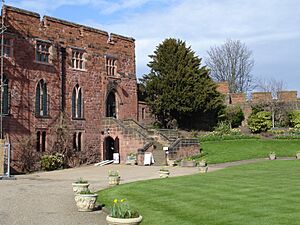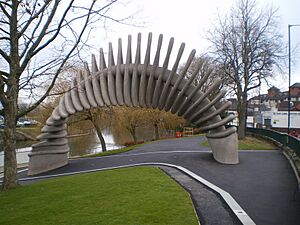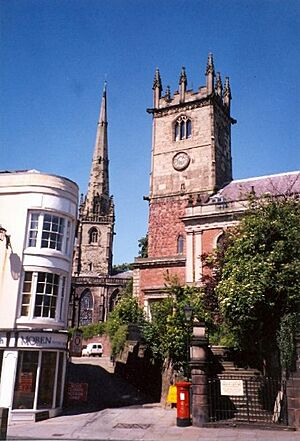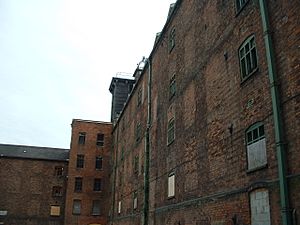History of Shrewsbury facts for kids
The town of Shrewsbury in Shropshire, England, has a long history, going back at least to the year 901. It might have been settled even earlier! During the Middle Ages, Shrewsbury was very important because it was a big center for trading wool. However, during the Industrial Revolution, the town didn't grow as much as other places. Still, it became a key railway town once trains started running in the area. Today, Shrewsbury still has many of its old, historic buildings.
Contents
How Shrewsbury Started
Scientists found proof in 2017 that people lived in the Shrewsbury area over 4,000 years ago, even before 2,000 BC! They found religious items near a church called the Church of the Holy Fathers in Sutton, which might make it Britain's oldest place of worship.
Many believe that people from a nearby Roman city, Viroconium Cornoviorum, settled in Shrewsbury around the 400s AD. But the first solid proof comes from the Saxons in the 600s.
Shrewsbury was likely founded as a town in the 700s by the Saxon rulers of Mercia. They needed a strong, fortified town, called a burh, to control where people crossed the River Severn. This spot was important on the road between other burhs like Hereford and Chester. Shrewsbury took the place of the large Roman town of Viroconium Cornoviorum, which was only 5 miles away near modern-day Wroxeter. We don't have exact records of when Shrewsbury was founded. Its name comes from the Saxon name "Scrobbesbyrig."
Old Roman coins and pottery have been found inside the river loop where Shrewsbury is. This suggests there might have been a small settlement or a path across the river's bend. There were natural shallow spots, called fords, across the River Severn near where the English Bridge and Welsh Bridge are today. These allowed people to cross the river. One ford was near the Welsh Bridge, and another was near the English Bridge, where the Rea Brook meets the Severn. This area was wide and shallow, making it easy to cross. An island called Coleham Island was here, and some think it might have been an early Saxon settlement.
The first time Shrewsbury was written about was in the year 901, when it was called a "city." Back then, it was part of the Kingdom of Mercia and was an important border town between the Anglo-Saxons and the Britons in Wales. By the time Athelstan was king (925–939), Shrewsbury was making its own coins. This meant the town had to be fortified, or protected, by law. Shrewsbury quickly grew in importance and became the main town, or county town, of Shropshire by the early 1000s. By 1066, it had over 250 houses and four churches: St Chad's, St Mary's, St Alkmond's, and St Julian's. At least three of these were important churches called minsters.
The Middle Ages

The Normans, who came from France, built a wooden fort in Shrewsbury. But in 1069, an alliance of Welshmen and people from Cheshire attacked it. A force led by Brian of Brittany and William fitz Osbern was sent to help, but the rebels burned the town and left before they arrived. Roger de Montgomery, a relative of William the Conqueror, became the first Earl of Shrewsbury. In 1074, he started building a stone castle where Shrewsbury Castle is now. He also founded the Shrewsbury Abbey in 1083. The castle was built in a strong defensive spot, controlling the only land entrance into Shrewsbury. The rest of the town was protected by a loop in the River Severn. Later, walls were built around the town for even more protection. You can still see parts of these walls today, especially along the river in the town wall gardens.
The center of Shrewsbury is located in a bend of the River Severn, and the town is only 9 miles from the Welsh border. The town center has a noticeable hill on the north side of the river bend, where the castle sits. The current castle was built in the 1200s. The original town probably only covered the top of this hill. It likely expanded south in the 1200s, as the town received permission in 1218 to collect a toll called murage to build town walls. This was one of the first times this happened in England. It also received permission in 1266 to collect money for paving new market areas. Many old, well-preserved "half-timbered" houses (black-and-white buildings) are still here, like the Abbot's House from around 1500 and Rowley's House.
Welsh forces led by Llywelyn the Great captured the town in 1215 and again in 1234. After these attacks, the town's defenses were greatly improved. In 1283, King Edward I held a Parliament (a meeting of important people) at Shrewsbury Abbey. This was the first Parliament to include a "House of Commons," where ordinary people were represented. They met to decide what would happen to Dafydd ap Gruffydd, the last free Welsh ruler. Dafydd was executed in Shrewsbury for high treason, which means betraying his country.
Shrewsbury is often thought to have been most important in the late Middle Ages. This was mainly because it was a major center for the woollen trade. It was a place where Welsh cloth was finished. Shrewsbury merchants would buy cloth that had been woven but not yet completed, like friezes. After they finished the cloth, much of it was sent to London to be sold.
16th and 17th Centuries
Later, after the Church of England was formed, it's believed that King Henry VIII offered Shrewsbury the chance to become a cathedral city. This would have made it the main city for a new "Diocese of Shropshire." However, people in the town supposedly said no! They preferred to stay a "first of towns." This is where the term "Proud Salopian" comes from, referring to someone proud of Shrewsbury just the way it is.
Because of its importance, many grand buildings were constructed during this time. These included Ireland's Mansion (built in 1575) and Draper's Hall (1658). Also during this period, Edward VI allowed the creation of a free school, which later became Shrewsbury School. It was first built in Castle Gates and stayed there until it moved to its current location in Kingsland in 1882.
The first history book about Shrewsbury was written in 1616 by Oliver Mathews. He was a Welsh apothecary (like a pharmacist) and a burgess (a citizen with special rights) of Shrewsbury.
During the English Civil War, Shrewsbury was a strong supporter of King Charles I (a royalist stronghold). It only fell to the Parliament forces when a traitor let them in through the St Mary's Water Gate, now called Traitor's Gate. Around this time (1640s and 1650s), Richard Baxter, an English Puritan church leader, tried to establish a university in Shrewsbury. It would have been only the third university in England, using the Shrewsbury School buildings. But there wasn't enough money, so it didn't happen.
Historically, Shrewsbury has been known for some special food products. These include the most popular recipe for Simnel cake and Shrewsbury Biscuits (or Shrewsbury Cakes). These lemon-flavored biscuits were first made in a bakery in the town center.
The Industrial Revolution
Shrewsbury didn't experience the huge growth that other English towns did during the Industrial Revolution. Not many large factories were built here. However, the world's first iron-framed building, the Ditherington Flax Mill, was built in the town in 1797. In the 1830s and 1840s, the town's population actually decreased. This was mainly because it didn't have good transport links or much industry.
However, railways became a major employer by the end of the 1800s. Shrewsbury became an important railway town. Today, the town still isn't heavily industrial, and the railways don't employ as many people as they once did.
20th Century
Shrewsbury was hardly bombed during World War II. This means many of its old buildings are still standing. There wasn't much new building, except for some cases in the 1960s and 1970s where important medieval buildings were sadly lost. They were replaced with newer buildings that didn't quite fit a medieval county town.
The town also played a part in the Cold War. It hosted a regional headquarters for the Royal Observer Corps (HQ 16 Group ROC) until the Corps was disbanded in 1995. This protected, atomic-bomb-proof building was built in 1962 near the Abbey. It operated until 1992 and is now a veterinary practice.
Shrewsbury is known as the "town of flowers." Another name for it is Salop (and Salopia is another name for the county). Shrewsbury's Welsh name is Amwythig.
21st Century

For many centuries, Shrewsbury had borough status and was run by the Corporation of Shrewsbury. Between 1974 and 2009, there were two local authorities: Shrewsbury and Atcham Borough Council and Shropshire County Council. However, since April 1, 2009, the town no longer has borough status. Now, the only local council is the county-wide unitary authority called Shropshire Council. With this change, the town was divided into parishes, and it now has its own town council.
See also



